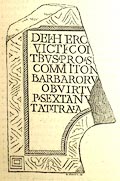







 next page
next pagerewarded with the torque (bis torquata)." It is quite evident, therefore, that the Ala Petriana was what would be called now-a-days a crack regiment, and must have taken an important share in the events transacted in the north-west of England in Hadrian's time. Although the Italian inscription does not say that the Ala was then in Italy, the feeling which the reading produces is that it was. It probably came to Britain with Hadrian.
We first of all hear of the torque in Roman history in connection with Titus Manlius. Having vanquished a Gaul whose neck was adorned with a twisted band of gold, he took it from his foe and placed it on his own person. He was called Torquatus from the circumstance. Permission to wear the torque was afterwards accounted a mark of honour. We need not suppose that in the case of a whole regiment each individual wore a neck-band of gold or bronze. The torque may have been adapted to the arm or wrist, or may have even degenerated to a medal with one or more clasps: or perhaps the torque may have been appended to the standard. Some bronze armlets, very uncomfortable to wear, have been found in some of our Roman stations. I have two in my possession, which are said to have been found in Birdoswald. Perhaps they have been worn by some members of the Ala Petriana when entitled to claim the distinction of torquata.
list, The origin of the name Petriana is uncertain. It seems clear now that the ala did not take its name from the station (Walton House or Cambeck Fort) in which it was qtred, but that it had it before coming to Britain. How it arose is not known.
It may be necessary to remark that the ala or wings of the Roman army were always cavalry, and were auxiliary troops, not native Italians.


A second, but smaller stone, found near the former, furnished the subject of another paper by Dr. Bruce. We are indebted to the courtesy of P. H. Howard, Esq., of Corby, and John Gough Nichols, Esq., for the accompanying accurate representation of the slab.
Dr. Bruce exhibited drawings of Roman and Ancient British Remains, sent to him by Mr. Mackie of Carlisle, and then said:-
"At our last monthly meeting, I had the pleasure of laying before the members an interesting fragment of an important Roman inscription discovered at Carlisle. Since that period another inscribed stone has been exhumed on the same spot - (the site where the buildings for the new offices of the 'Carlisle Journal' are



 Gents Mag 1860 part 1 p.348
Gents Mag 1860 part 1 p.348